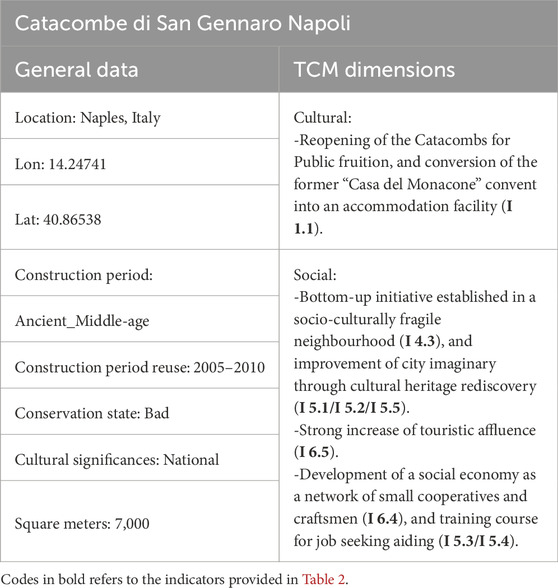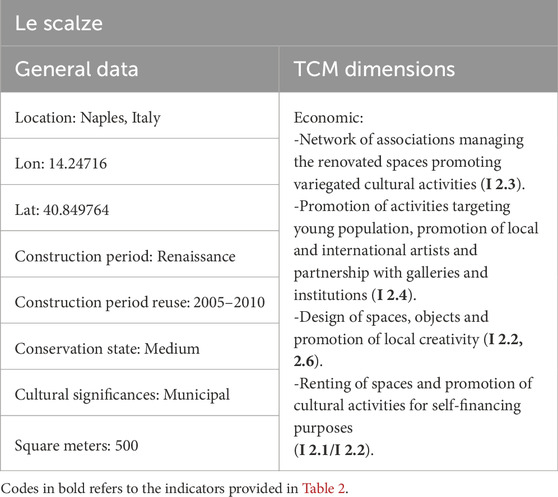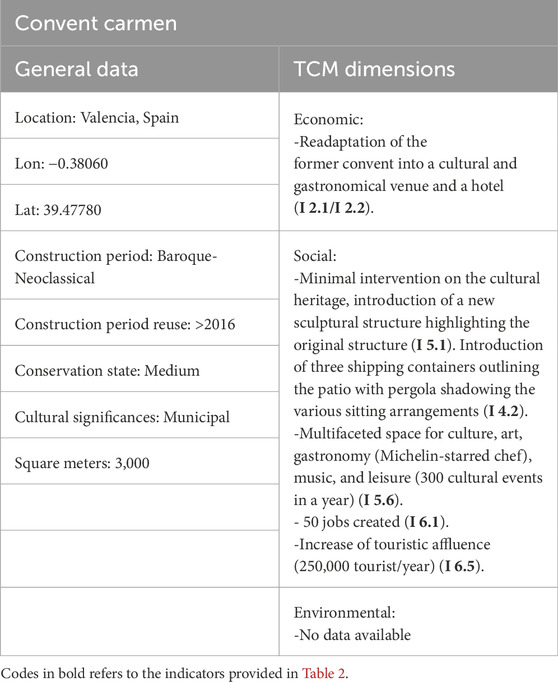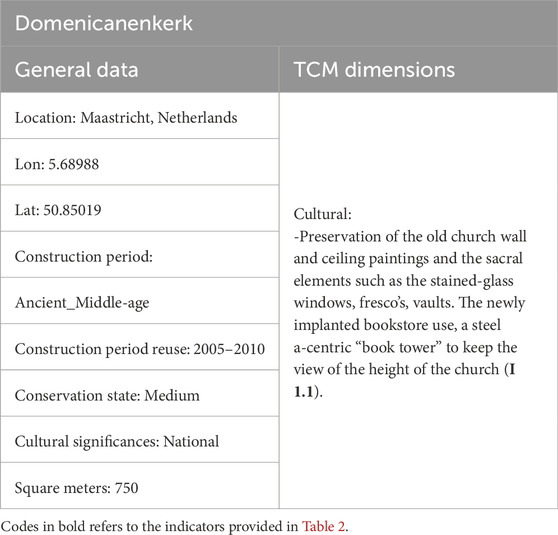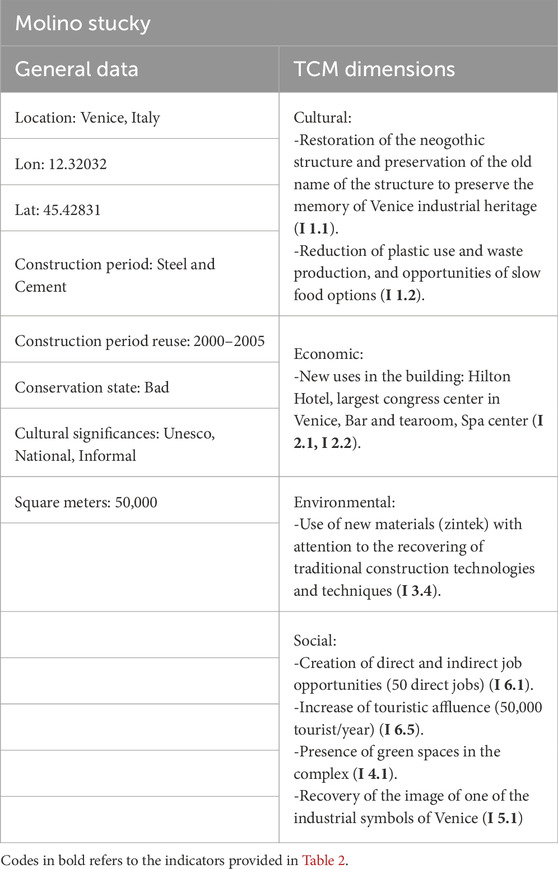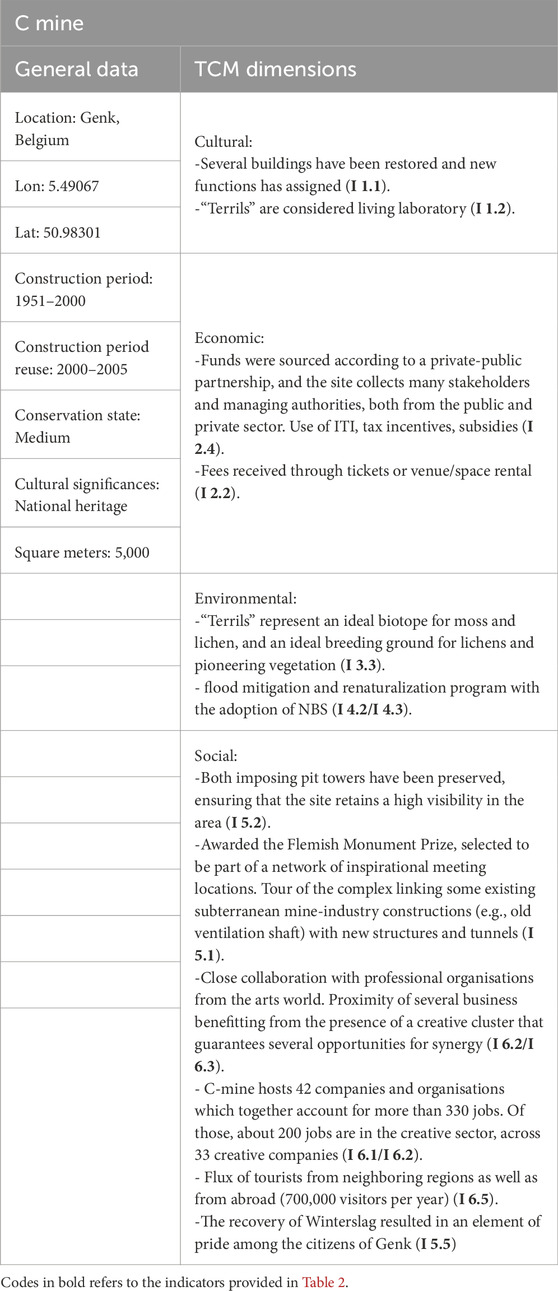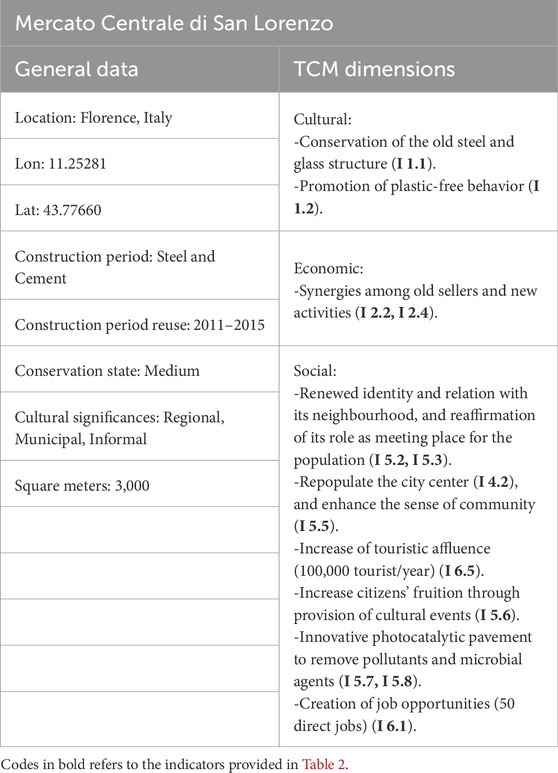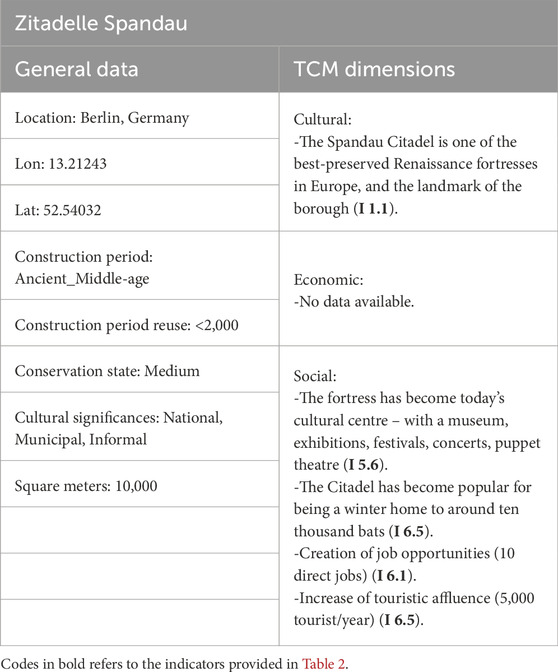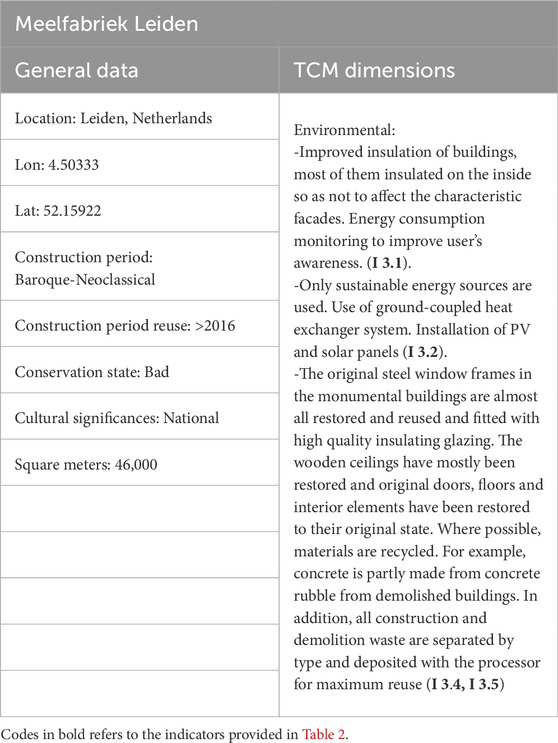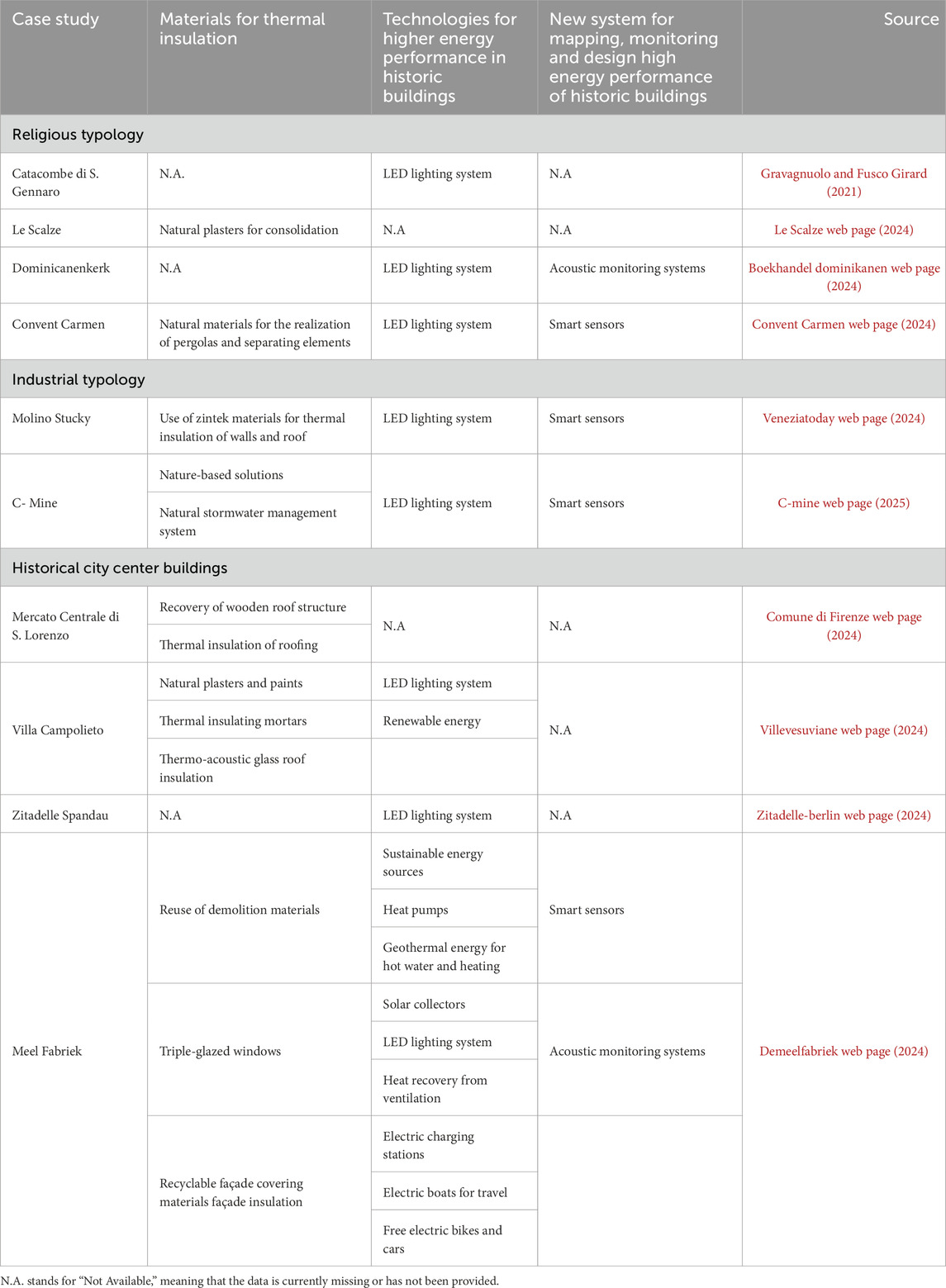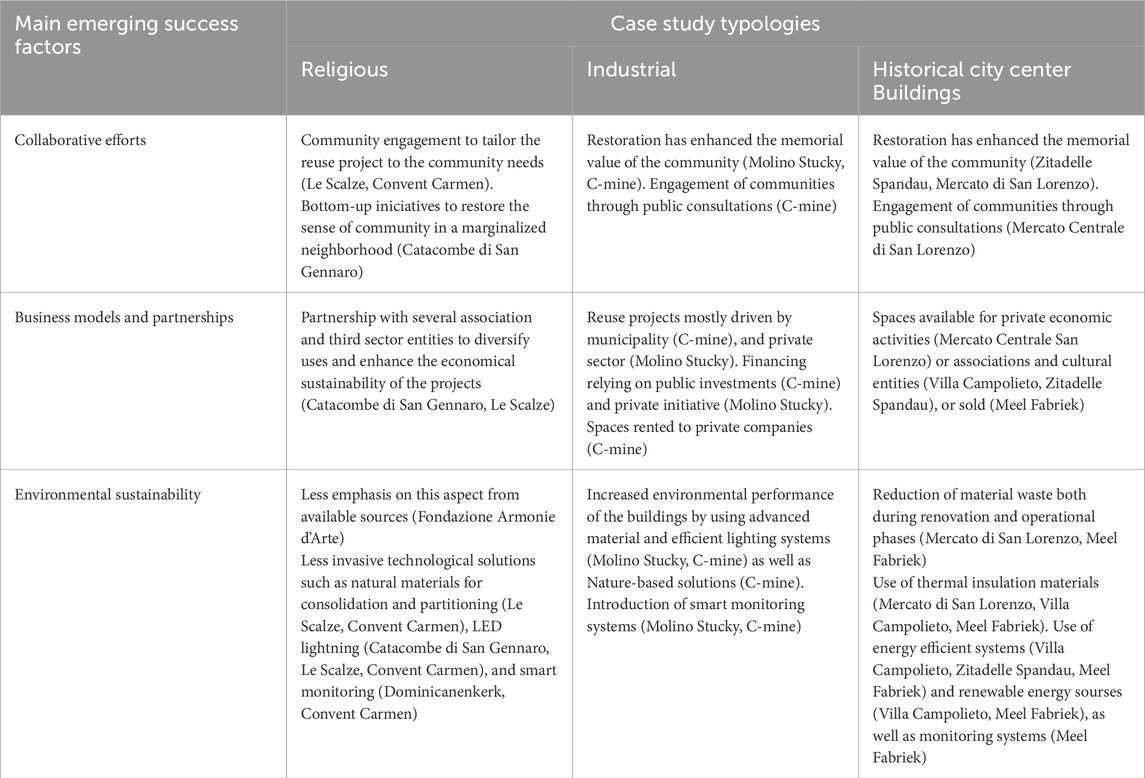- 1Engineering Department, Pegaso Telematic University, Naples, Italy
- 2Interuniversity Department of Regional and Urban Studies and Planning - DIST Politecnico di Torino, Turin, Italy
- 3CNR ISPC - Institute of Heritage Science, Naples, Italy
- 4Professor Emeritus University of Naples Federico II, Naples, Italy
Climate change, pollution, and inequalities are prominent issues in cities and regions, calling for an ecological and cultural transition towards a sustainable society where wellbeing, quality of life, ecosystems human health and equity are prioritized. Circular economy and circular city models offer frameworks for achieving these objectives, promoting symbiotic relationships between different forms of capital within urban ecosystems: economic, environmental, social, cultural, institutional and human capitals. Historic urban areas, through the adaptive reuse of cultural heritage, can contribute to the circular economy model, enhancing urban metabolism while preserving cultural integrity. Co-design and co-planning processes involving stakeholders and communities are essential to realize the circular city, thus integrating conservation with development. The aim of this paper is to conduct an ex post analysis of cultural heritage adaptive reuse projects in Europe, that are particularly well “performing” from the perspective of the circular economy implementation in cities and regions. Circular economy is interpreted not only in terms of reuse/regeneration of waste, but also has promoting a new mindset. These examples are examined based on specific criteria and indicators from the EU-funded Horizon 2020 CLIC research project, identifying success factors, tools, and models emerging from good practices that can potentially be replicated and transferred for the circular adaptive reuse of Italian cultural heritage. Particular attention in the selection of case studies has been given to the co-planning and co-design experiences activated, to highlight the social innovation capacity of the analysed adaptive reuse projects.
1 Introduction
In the age of Anthropocene, new societal challenges are emerging, linked to the need of regenerating natural resources, reduce pollution and greenhouse gas emissions, and restore the democratic dimension of “living together” (CLIC Project, 2025). These challenges require taking into account the needs of present and future generations and addressing the progressive depletion of natural and relational capital (Fusco Girard et al., 2023).
Climate change, pollution and growing poverty are acknowledged as the most important challenges of our society, contributing to social and political global instability (Yunus, 2018). These challenges are particularly reflected in cities, because these are areas where most of the world’s population lives, where, in addition, most of the sources of pollution are located. It is required an ecological transition that is capable of reconnecting the economic, social and urban systems with nature. However, this transition needs to be based on a cultural transition. This means that a new evolutionary vision of a sustainable society, where people and nature thrive in synergy, is needed (Fusco Girard et al., 2023).
Wellbeing, good living, quality of life, and health become the strategic goals. These goals are closely connected to a better distribution of resources, wealth and opportunities, which are linked to greater equity, inclusion as well as respect for ecological thresholds (Raworth, 2018). Thus, wellbeing becomes the fundamental objective of any development strategy, while economy represents a means. This is reflected on the territory, urbanisation, and the evolutionary dynamics of the cities (Fusco et al., 2024).
To realize the “good city,” the “city of good living,” the “city of sustainable human development” a strategy of humanisation is needed, where the individual/person can become a promoter or “entrepreneur of humanity,” thus it is necessary to reduce the gap between the status quo and what is considered “desirable” (Fusco Girard et al., 2023). This means that both man-made and natural capital and relational/social, human capital should be improved. Regenerative strategies of these different forms of capital are needed simultaneously. In other words, there is a need to improve the relationship between the city and nature with specific innovative “bio-reconnections” between the city and the networks of life, i.e., ecosystems (Fusco Girard et al., 2023).
On the other hand, it is necessary to improve the relationship between person and person to promote community: to promote an educating city, to cultivate a sense of identity and belonging, and to encourage active citizenship. This involves promoting the ability to take care of the city itself and its cultural and natural heritage. It is necessary to make cities and human settlements inclusive, safe, resilient, and sustainable (Goal 11, Agenda 2030) (United Nations, 2025).
1.1 The circular economy and circular city model in historic cities
Urban planning is a discipline that today needs to examine how the costs and benefits of the ecological/energy transition are distributed among different social groups and between the current and future generations, in line with internationally agreed goals (United Nations, 2025; United Nations, 2016; Ellen MacArthur Foundation, 2015; European Commission, 2019; European Commission, 2020a).
International policy documents and studies indicate that the circular economy is increasingly recognized across various sectors as a model to drive the ecological transformation of our cities.
The circular economy is based on the ideally infinite extension of the lifespan of goods, the transformation of waste in resources, the use of renewable energy sources, and the general concept of synergy/symbiosis between business sectors and social actors, in order to generate positive social and environmental impacts through economic activities. The concept of circular economy was developed starting from the industrial sector (Chertow, 2000), integrating the idea of synergies/symbioses with Social and Solidarity Economy models (Moreau et al., 2017), and then evolving into a broader concept of circular urban development (Ellen MacArthur Foundation, 2017; Prendeville and Bocken, 2017).
This concept goes beyond its traditional definition centred on reuse and recycling of wastes. It is intended as an economy aligned with nature and fostering co-evolution. When translated into spatial and territorial terms, the circular economy model manifests as the circular city model, an approach to urban regeneration targeting deprived, underused and abandoned urban areas. This model generates multidimensional benefits encompassing economic, environmental, and socio-cultural aspects simultaneously. This city model is characterised by a system of relationships that links different forms of capital (both tangible and intangible) in a systemic perspective, where urban regeneration processes become multipliers of relationships between different actors.
A “circular city” is an urban development model that applies the principles of the circular economy to urban planning and management, promoting the efficient use of resources, waste reduction, the adoption of renewable energy, and the creation of local systems that encourage symbiosis between industrial activities, communities, and ecosystems (Gravagnuolo et al., 2019). In a circular city, the goal is to create an urban environment that minimizes environmental impact while maximizing the reuse, recycling, and regeneration of resources, while simultaneously supporting an inclusive and sustainable economy.
According to the Ellen MacArthur Foundation (2017), a circular city integrates the principles of the circular economy into the design and management of urban infrastructures, promoting resource management that goes beyond the traditional linear model of extraction, production, consumption, and disposal (Ellen MacArthur Foundation, 2017). Additionally, Prendeville and Bocken (2017) highlight how the development of circular cities involves creating local networks that promote cooperation between industrial sectors, institutions, and citizens, with the aim of improving quality of life and reducing the ecological footprint (Prendeville and Bocken, 2017). The circular model is thus not only an issue of reuse of materials, but it is also a cooperative way of thinking.
The circular economy and circular city, accelerated by innovations in digital technologies (IoT, automation, big data, etc.), necessitate the adoption of strategies to achieve energy transition objectives. Indeed, various forms of symbiosis should be considered for the implementation of the circular city: symbiosis within and between industrial districts; symbiosis between the industrial district and the city; symbiosis between the industrial district and the port; symbiosis between the city and non-urban territories (agricultural/forestry); and symbiosis between large cities and small towns/villages in rural areas (Fusco, 2020a).
In the perspective of the city transition to the circular economy model, historic urban areas could also be redeveloped to become more self-sufficient in energy, water, and materials. Using nature-based solutions to re-naturalise and make historic urban neighbourhoods healthier is crucial. Existing cultural heritage within historic city centres, if appropriately reused from an energy and environmental point of view, can contribute to the ecological transition of cities.
1.2 Co-designing and co-planning the circular city through adaptive reuse of cultural heritage for improving inclusion
The adaptive reuse of abandoned and underused cultural heritage sites should be considered within the context of the circular economy, aligning with the principles of a circular city. The adaptive reuse of cultural heritage represents an effective strategy for implementing of the circular city, facilitating enhancements to the urban metabolism.
According to Douglas, adaptive reuse refers to “any building work and intervention aimed at changing its capacity, function or performance to adjust, reuse or upgrade a building to suit new conditions or requirements” (Douglas, 2006), which allows for conserving the different values of cultural heritage: both the use value and the intrinsic one. Adaptive reuse “extends the building’s [or properties] physical and social functions by giving the building a new purpose while conserving its historic and cultural significance” (Conejos et al., 2011). It enables the extension of a building’s life cycle, aligning with the principles of the circular economy, which aim to prolong the lifetime of resources for as long as possible and avoid resource consumption.
When heritage buildings are repurposed for new functions, it is essential to preserve as much of the originality and architectural features of the building as possible (Mısırlısoy and Gunce, 2016), thus identifying boundaries in the management of change. This new use has to be appropriate in terms of conserving its cultural significance and intrinsic value (Fusco, 1987; Fusco and Vecco, 2019). The restoration, rehabilitation, and adaptive reuse of cultural heritage are consistent with the circular economy principles. Adaptive reuse differs from that of the linear model, both in terms of design, and operational and management terms (Fusco, 2020b; Fusco and Gravagnuolo, 2024).
This adaptive reuse should be integrated into the ecological transition outlined in the European Green Deal and in the Renovation Wave strategy, involving a connection to CO2 capture, water management, recycling, renewable energy utilization, and circular waste management (European Commission, 2019; European Commission, 2020b).
Hence, integrating adaptive reuse into the revitalization of historic urban districts and local urban planning enhances its effectiveness. One of the challenges facing urban conservation is improving the energy performance of the built environment without impacting the cultural integrity of the building and the environment (Angrisano et al., 2021). Design solutions should be energy-efficient and propose the use of innovative materials and technologies (Gravagnuolo et al., 2020).
For example, the ENERPAT project (European Commission, 2014) represents a good practice in this perspective. It is a European project that involved the thermal renovation of buildings in the historic centre of Cahors (France), Vitoria-Gasteiz in Spain and Porto (Portugal) through the use of bio-based materials produced by local craftsmen for the thermal insulation of the buildings, the most modern technologies for the production of green energy, and the use of “Nature-Based Solutions” (NBS) (European Commission, 2014).
In addition, recent European legislation on Renewable Energy Communities can provide a driver for energy transition in historic urban areas, but technologies and materials compatible with historic and cultural buildings need to be further developed (e.g., GBC Historic Buildings, Levels). Stakeholders responsible for the preservation and maintenance of historic buildings (public and private owners, managers, superintendencies) could use advanced evaluation tools capable of assessing performance (energy, water, waste, materials) from a circular perspective. These tools can support experts in retrofit and transformation processes of cultural heritage, and take into account the point of view of communities regarding transformation proposals. This approach implements the UNESCO Recommendation on Historic Urban Landscape and the New European Bauhaus, which focus on the challenge of “humanizing” development.
The circular economy model should be understood not only in terms of quantitative aspects such as reuse, recycling, and regeneration of physical components and materials, but also in terms of intangible elements (Fusco Girard et al., 2023). This holistic approach is crucial for making meaningful improvements in our choices today, supported by appropriate evaluation methods and processes. In addition to addressing physical resources, the circular economy acknowledges the importance of cooperative and inclusive values that need to be fostered in alignment with sustainability principles. In this context, the role of communities in the shared care and management of cultural heritage and landscapes is widely recognised but rarely implemented.
The evaluation of alternative scenarios of cultural heritage reuse projects and the involvement of stakeholders in co-design and co-planning are fundamental. In Italy, the “public debate” and evaluation process were also reinforced by the Italian Constitutional Court’s Sentence 235/2018, which emphasised the need to compare project alternatives and implement participation as a fundamental tool for improving inclusion and also local democracy. Public debate is mentioned in Article 22 of the Public Contracts Code, while the National Commission for Public Debate has been established by DM 627/2020. To achieve the public interest, the public sector can also collaborate with the Third Sector. In recent years, new tools for the shared governance, administration and collective care of common goods emerged, such as the Collaboration Pacts (LabSus), adopted by more than 300 cities in Italy, in line with Article 118 of the Italian Constitution (principle of subsidiarity). Law 117/2017 and Constitutional Court Sentence no. 131/2020 focus on the possibility for public institutions to cooperate with Third sector actors to achieve public interest objectives.
However, despite the clear regulatory orientation towards greater community participation in decision-making processes and the use of decision support and evaluation tools, there is still a lack of expertise and practical experience. In this perspective, Community Led Local Development (CLLD) represents an approach to participatory planning, that can support local regional development. It is an important tool that actively involves the local community in the design, implementation, and monitoring of heritage development and regeneration initiatives (Ministero dell’Ambiente e della Sicurezza Energetica, 2022).
In Italy, Local Action Groups (GAL) have worked on projects to promote sustainable tourism, valorize local products, and preserve cultural heritage, particularly for rural and territorial development, through the implementation of projects financed by European and national funds (Ministero dell’Ambiente e della Sicurezza Energetica, 2022). This measure in Europe has been used in different European countries, such as Spain, Poland, Ireland and France, to support local development projects especially in rural areas, focusing on the valorisation of natural and cultural resources and the involvement of local communities.
The “National Strategy for Sustainable Development” represents another important action plan for the valorization of Italian landscapes and cultural heritage. Approved on 18 September 2023 by the Interministerial Committee for Ecological Transition (CITE), this strategy places participation at the foundation of every development project (Angrisano and Nocca, 2023). The document underwent broad consultation among public and private stakeholders to define appropriate actions to achieve the 17 Sustainable Development Goals set forth in Agenda 2030.
To achieve the UN goals, the strategy starts from the concept of the “five P” that connect economic, social, and environmental issues: people, planet, prosperity, peace and partnership (Angrisano and Nocca, 2023). The goal of the plan is to manage natural resources sustainably, aiming to reduce greenhouse gas emissions and promote sustainable economic wellbeing, but above all, to achieve social sustainability by addressing issues such as employment, respect for individuals and the respect for minorities (Gravagnuolo et al., 2024). Active participation becomes a key element, ensuring a well-structured and inclusive development path. This process envisions a broad and participatory approach in which all involved actors, both institutional and civil society, are called upon to contribute (Gravagnuolo et al., 2024; Verardi et al., 2023; Olejniczak et al., 2024).
Participatory processes can be developed through the so-called “policy lab.” Indeed, according to a study by Olejniczak et al. (2024); Assefa and Ambler (2017), it emerges that “policy labs” are becoming increasingly prevalent worldwide, with the mission of supporting collaborative design. This trend emerged less than a decade ago, and a recent study has identified as many as 78 “policy labs” in the European Union alone (Assefa and Ambler, 2017). While the concept of policy labs has gained significant traction, the term is often associated with the establishment of labs, design thinking, behavioral insights, collaborative governance, and social entrepreneurship. Nonetheless, the emerging practices of “policy labs” are demonstrating promising innovations in the public sector’.
1.3 The role of technological and energy solutions in the adaptive reuse according to the New European Bauhaus
The New European Bauhaus (NEB) is a European Commission initiative launched in September 2020. Inspired by the innovative spirit of the Bauhaus movement of the last century, known for its integration of art, architecture, design, and technology to promote innovation and sustainability (European Commission, 2020a), the aim of the New European Bauhaus is to bring together creativity, culture, social inclusion, and sustainability to co-create new solutions for our living spaces. The initiative seeks to promote a more sustainable and resilient development in Europe by engaging citizens, designers, architects, businesses, scientists, and policymakers in developing projects and proposals that integrate beauty, sustainability, and inclusiveness into our everyday environments, such as buildings, public spaces, and urban landscapes (European Commission, 2020a).
The New European Bauhaus (NEB) underscores the importance of high-quality projects that integrate technology with art and design, prioritize the use of sustainable materials (such as bio-materials), promote energy-efficient buildings, and utilize the latest technologies.
Currently, numerous scientific studies (Assefa and Ambler, 2017; Baker et al., 2017; Foster, 2020; Elefante, 2007; Kubbinga, 2017; Munarim and Ghisi, 2016; Thornton, 2011) catalog innovative solutions for cultural heritage reuse, particularly focusing on the use of green materials and new technologies, able to improve and monitor energy performance.
Therefore, Table 1 presents an abacus of the most effective technical solutions, derived from an earlier study by Angrisano et al. (2024). This abacus is based on the analysis of specific case studies of historic building reuse projects authorized by the Italian Ministry of Cultural Heritage (MIC). Some of these case studies were documented in the Ministry of Cultural Heritage report “Guidelines for the Improvement of Energy Efficiency for Cultural Heritage” (2015), while others are related to projects conducted by the Green Building Council (also authorized by the MIC) (Gravagnuolo et al., 2024). Within the proposed abacus, materials and technologies are divided into the following categories: Thermal insulation, Technologies for improved energy performance in historic buildings, and New systems for mapping, monitoring, and designing high-energy performance in historic buildings (Table 1).

Table 1. Abacus of technological solutions adopted and materials used for the reuse of cultural buildings.
1.4 Objectives of this paper
This paper is based on the results of the EU-funded Horizon 2020 CLIC project (CLIC Project, 2025), beginning with a database of good practices analysis of cultural heritage adaptive reuse and identifying case studies particularly “performing” in terms of circularity, based on the criteria and indicators identified in the CLIC project. The aim of this paper is to conduct an ex post analysis of cultural heritage adaptive reuse projects in Europe, that are particularly well “performing” from the perspective of the circular economy implementation in cities and regions. The paper aims to examine these case studies in depth, identifying the success factors, tools, models, and processes that represent good practices which can potentially be replicated and transferred for the circular adaptive reuse of European cultural heritage.
The objective of this first phase is to create a database of exemplary cases (CLIC database of best practices, 2019), at both national and international levels, to make them accessible to researchers, professionals, and public administrations. Particular attention in the selection of case studies will be paid to the co-planning and co-design experiences activated within the reuse projects, to highlight the social innovation capacity of these projects. The selected case studies will be analysed using a multidimensional set of qualitative, quantitative and economic/financial indicators in order to examine the impacts of transformations through a multidimensional and transversal approach.
2 Methodology
2.1 Selection of the best practices
The linkage between adaptive reuse and circular economy has led to the conceptualization of the triple circular model (TCM) of cultural heritage adaptive reuse, based on three key principles: Autopoietic, Generative, and Symbiotic principles (Gravagnuolo et al., 2017). This model is built upon a matrix of criteria used to evaluate the responsiveness cultural heritage adaptive reuse interventions to circular economy principles (Gravagnuolo et al., 2017), composed by three aspects: (i) Cultural values preservation (extending the lifetime of heritage buildings/sites/landscapes, leveraging the potential of the “intrinsic value” of cultural heritage); (ii) Circularity of conservation intervention (considering the closing of “micro-metabolisms” of energy, water, materials and wastes), (iii) Circularity of outcomes from the new uses (considering the economic, social and landscape impacts generated in the local context) (Gravagnuolo et al., 2017).
Additionally, a fourth aspect related to the sustainable management of the cultural object in the long run is included (Fusco and Gravagnuolo, 2024). The triple circular model evaluates the success of the adaptive reuse of cultural heritage in its capacity to re-generate the resources needed for its functioning (Autopoietic principle), generate positive economic, social, environmental, and cultural impacts (Generative principle), and to establish relations of mutual benefits with its surroundings (Symbiotic principle) (Fusco and Gravagnuolo, 2024).
Building on the triple circular model, the CLIC project indicates six variables/criteria to assess the level of circularity of an adaptive reuse intervention, associated to a set of indicators, as displayed in Table 2 (Gravagnuolo et al., 2017). These criteria and indicators have been classified according to the three dimensions of sustainable development, i.e., the economic, environmental and social sustainability (called the triple bottom line), with the cultural dimension in addition.
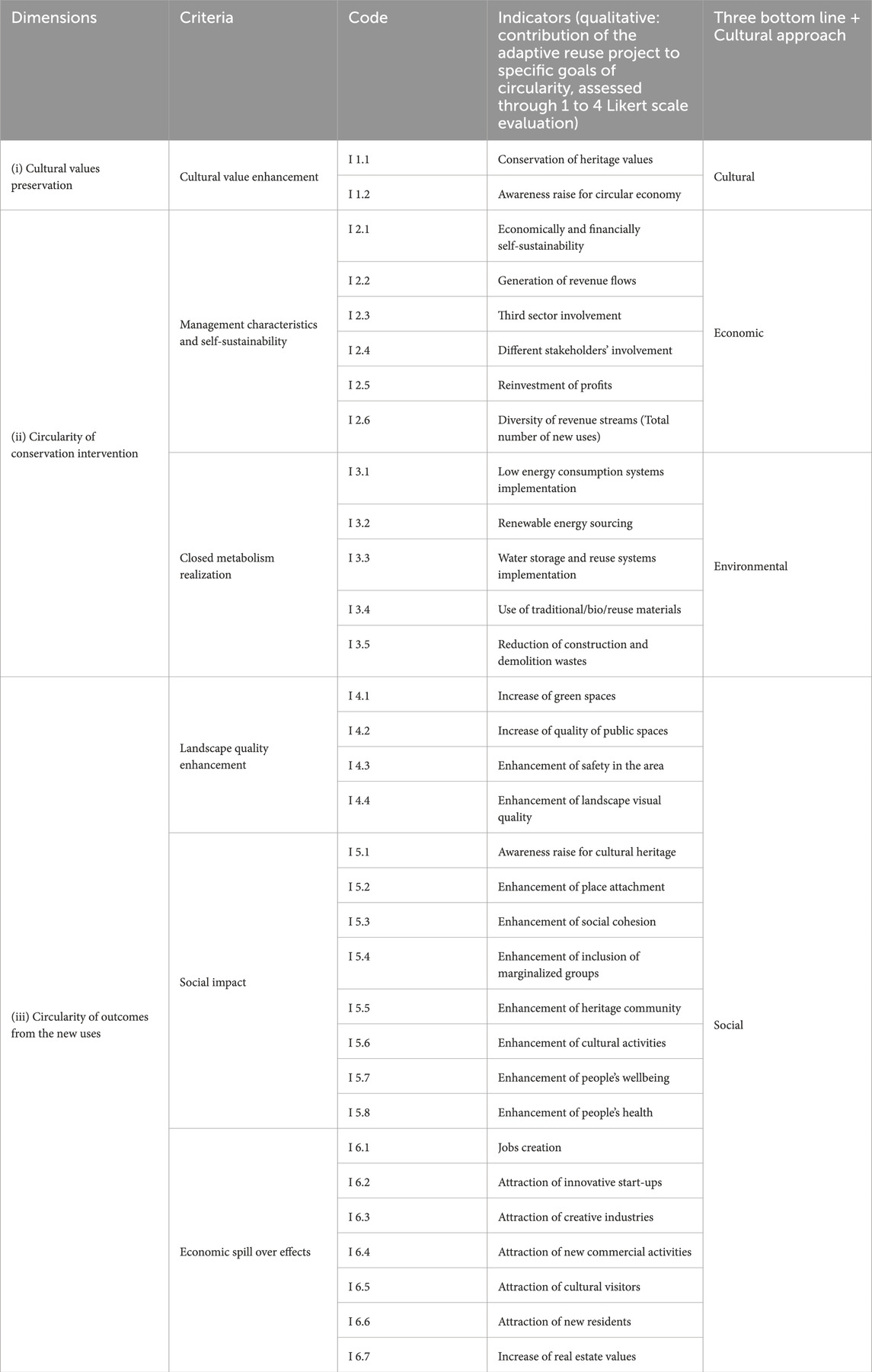
Table 2. CLIC project variables/criteria and indicators and reshape in Triple bottom line + Cultural dimensions.
Coherently to the triple bottom line approach, which considers environmental, social, and economic dimensions of sustainability, to which the cultural aspect could be add as a fundamental aspect when dealing with cultural heritage. The criteria framework proposed by the CLIC project have been reshaped into the following aforementioned dimensions (Table 2).
This study uses the CLIC database as a starting point for the selection of a set of informative case studies of best practices for cultural heritage adaptive reuse, focusing on three highly representative typologies across the European built cultural heritage: (i) Religious, (ii) Industrial, (iii) Historical City Center Buildings. There are several reasons for selecting these three typologies. The Religious typology represents a strategic type of cultural asset, as they usually date back a long time and are often located in central areas of the city. The Industrial heritage represents a quantitatively vast portion of the building stock due to its intrinsic extension. Furthermore, as a consequence of the progressive abandonment of cities by the industrial sector, these types of assets are now located in semi-peripheral areas of cities, with high potential impacts on their surroundings. Finally, the “Historical City Center Buildings” category is defined as the set of heritage buildings located in the city historic center.
A first extraction of case studies was conducted at the European level. Then, a more geographically bounded extraction was performed at the Italian level (it is worth noting that for the European-level extraction, the Italian case study was previously excluded from the list). Since the Historical City Center Buildings is not a stand-alone typology, its definition among the typologies considered in the CLIC dataset (Verardi et al., 2023), involved a simple filtering out of the previously considered typology (Religious and Industrial). Historical City Center Buildings case study was identified among the remaining entries of the dataset located in an urban context.
The selection of the case studies has been based on the four identified macro-criteria derived from the CLIC project: Cultural, Environmental, Economic, and Social. The total performance of the case studies has been calculated as a sum of the performance in each dimension as follow:
Where Utot,i is the overall performance of case study i, and Uc,i is the performance of case study i against criteria c. Few case studies present optimal performance across the full range of aspects investigated. To alleviate this issue, sets of best performing case studies have been built by selecting examples with high performance in the four different dimensions separately, in order to consider possible applicability of solutions among different case studies more focused on one aspect or another. In Figure 1 a graphical representation of the adopted workflow is presented (Figure 1).
3 Results of the case studies analysis
Table 3 presents the first analysis of the dataset in order to extract sets of best performing case studies across the four different dimensions of circularity according to CLIC: cultural (Cul), economic (Eco), environmental (Env), and social (Soc), and refer to the cluster of indicators specified in Table 2. CLIC database presents the level of performance of case studies against each performance criteria in a percentage scale. This scale has been reparametrized in a four point likert-scale ranging from 1: vary low performance level (0%–25% in CLIC percentages), 2: medium-to-low performance level (26%–50% in CLIC dataset), 3: medium-to-high performance level (51%–75% according to CLIC), 4: high performance level (76%–100% in CLIC dataset). The performance level of the case studies according to the specified likert-scale are presented in Table 3.
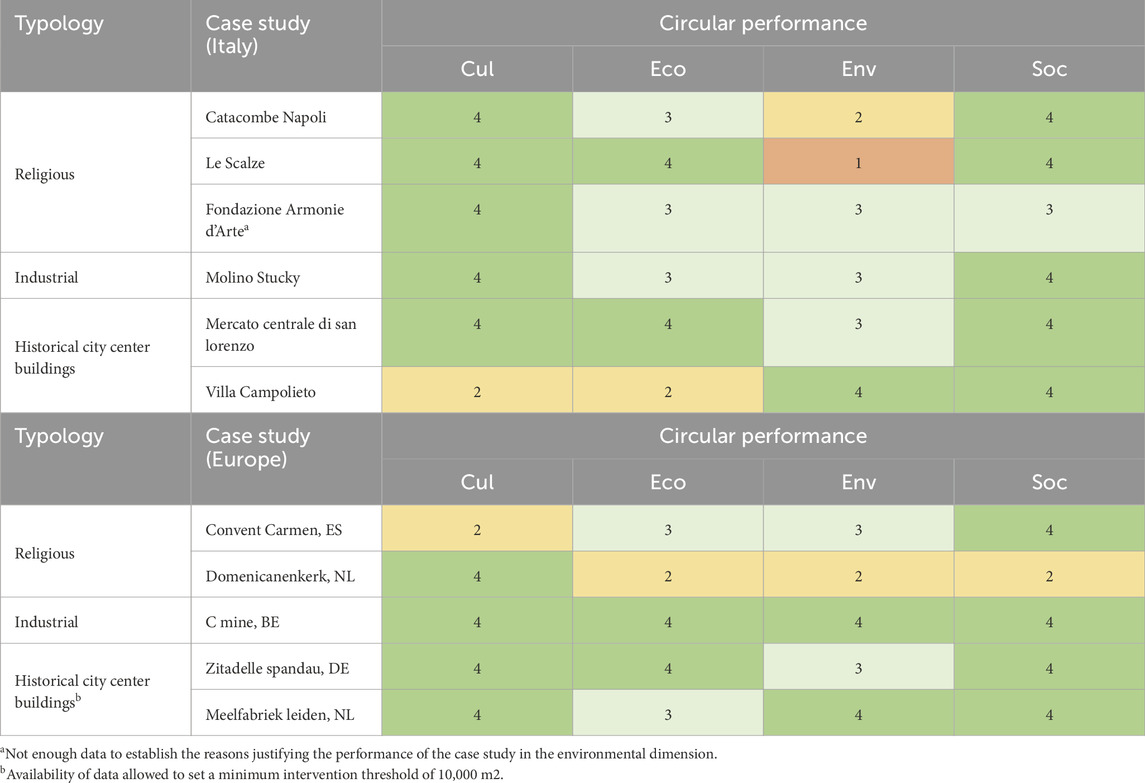
Table 3. Performance of the selected case studies against the four dimensions: cultural, economic, environmental and social.
Across all the typologies, most of the case studies are not capable of maximizing their performance in each dimension of the evaluation (i.e., none of the case studies scores 100% in each dimension). In those cases, the overall best performing case study was identified, and, for those dimensions in which this was not the best performing example, other case studies with the highest score in those dimensions were selected leading to the construction of a set of case studies with the highest scores in all the performance indicators. With reference to Table 3, for instance, taking the religious typology at the European level, “Convent Carmen” was the best performing case study overall, scoring the highest value in social, environmental, and economic dimensions, but with a relatively low cultural performance. On the other hand, the “Domenicanenkerk” case study has been identified among the best performing under the cultural indicator. By considering both the case studies, it could be possible to identify strategies that maximize the circularity index across all the dimensions considered, with the possibility to consider compatibilities among reuse practices. In Figure 2, the identified case studies are reported.
In Tables 4–13 the information justifying the performance of the different case studies against the four circularity performance dimensions are presented, namely,: Cultural, Social, Economic, Environmental, together with a mapping of information into the indicators of the TCM (according to the indicators code displayed in Table 2). Such information come mainly from online sources and grey literature, representing this also a valuable source of information regarding the narrative that is constructed around each of the case study, revealing the relevance that is given to different dimension of the circularity performance of a specific case study.
3.1 Religious heritage case studies
The set of Italian case studies for the religious heritage category is composed by “Catacombe di S. Gennaro Napoli” “Le Scalze” and “Fondazione Armonie d’Arte.”
Catacombe di S. Gennaro (Table 4) started from the reopening of the Catacombs of San Gaudioso in 2006, and Catacombs of San Gennaro shortly after (I 1.1). The project has a particular focus on social aspects due to its location in one of the city’s most complex neighborhoods, characterized by severe disparities among inhabitants (I 4.3). The outcomes of the recovery of the 13,500 m2 of the Cultural Heritage, including the creation of new jobs in the area (56 people employed) and the attraction of a consistent flow of tourists (200,700 tourists in 2022, I 6.5) span beyond its physical extensions by supporting the local social economy and developing a network of cooperatives (I 6.4) and the generation of a sense of attachment in the local community (I 5.1/I 5.2/I 5.5), thus being aligned with the Generative principle of the TCM (Catacombe di Napoli web page, 2024). The management of the site is also supported by the integration in several partnerships with other local entities of the Third Sector to promote projects that enhance the socio-economic development of the area, coherently with the Synergic principle of the TCM.
“Le Scalze” (Table 5) case has been selected due to its high performance in the Economic-related aspects, thus the information provided focus on this dimension of the TCM.
The “San Giuseppe delle Scalze” XVII century church has been reopened in 2005 by the “Forum Tarsia” association that since 2009 manages the spaces of the historical complex together with several other associations (I 2.3). This management form allows the complex to host several cultural activities throughout the year, as well as international events thanks to the partnership with galleries, institutions, and both local and international artists (I 2.4) (Le Scalze web page, 2024). These cultural activities, together with the renting of spaces of the complex guarantee the generation of revenues streams for the self-financing of the associations’ activity, and the maintenance of the complex (I 2.1/I 2.2). Again, the Generative principle of the TCM results satisfied, while the Autopoietic one is respected by the capacity of the managing structure to renew the Cultural Heritage and guarantee its survival in time.
The last selected case study is the “Fondazione Armonie d’Arte,” a private body with the mission to valorise the Scolacium archaeological park and the Squillace gulf in Catanzaro (Fondazione Armonie d’Arte web page, 2024). This case study is the one with the highest performance in Environmental performance according to CLIC database. Despite this, it was not possible to collect any information from publicly available sources to support this claim. Therefore, despite the environmental aspects of the project being highlighted by the respondent to the CLIC survey, they are not disclosed with the general public, highlighting the lack of interest to communicate these aspects, representing this an issue that might be further investigate. “Convent Carmen” in Spain and “Domenikanenkerk” in the Netherlands are the case studies with the best performances among religious case studies at European level.
“Convent Carmen” (Table 6) has been established in a former convent in Valencia with the aim of converting it into a cultural hub that also hosts an hotel and gastronomical facilities (I 2.1/I 2.2), keeping the economic sustainability of the operation in mind (Convent Carmen web page, 2024), with 50 new jobs created (I 6.1), and as many as 300 cultural events a year (I 5.6), generating a consistent flux of tourists (I 6.5). The rehabilitation project of the Cultural Heritage was particularly attentive to the materiality of the site to enhance the recognition of the historical value of the monument as a placemaking action (I 5.1), introducing also new elements in order to enhance the usability of the public space represented by the patio of the former convent (I 4.2). The privately-owned venue has been originated from a public consultation, during which a socio-cultural leisure center was first established in the area. This case study is also reported as highly performing under environmental aspects, for which, again, no useful information has been found from publicly available sources.
Finally, the case study among the European religious typology with the highest performance in the cultural dimension is the “Dominikanenkerk” (Table 7). The 13th-century “Dominikanenkerk” (Dominican Church) in Maastricht is the first Gothic Dutch church, characterized by elements of exceptionally great art-historical value (Boekhandel dominikanen web page, 2024). During its history, the monument has hosted extremely diverse functions: French cavalry stable, city depot, concert hall, slaughterhouse, snake house, boxing venue, bicycle shed. Finally, in 2006 a bookshop was established in the building.
To preserve the overall perception of the church, a two-floor a-centric steel structure has been erected to satisfy the new function’s spatial need, with a 400 m2 exposition surface, testifying to the project attention to the preservation of the cultural aspect of the historical building (I 1.1).
3.2 Industrial Case studies
Among the Italian case studies, “Molino Stucky” is the one scoring the best level of performance across all the dimensions of the TCM in comparison with all the other case studies in the CLIC database.
The story of “Molino Stucky” (Table 8) dates back to 1884 when it has been inaugurated in Giudecca Island in Venice (Veneziatoday web page, 2024). It was functioning until 1954, year of its shut down. In 2007, it has been reopened as a hotel.
The restoration process was carried out to preserve the Gothic structure of the building to the maximum degree, as well as the memorial value of this industrial symbol of Venice, an aspect also testified by the decision to keep the original name of the venue (I 1.1/I 5.1). From an economic sustainability perspective, the “Molino Stucky” is characterized by several newly implemented functions with a high capability to generate revenues. It attracts tourists interested both in visiting the structure itself, and in sojourning at the hotel or attending events in the largest congress center of the city (I 2.1/I 2.2). An interesting aspect of the project, driven by the great concern for preserving the cultural value of the building, is the choice to use traditional construction techniques while employing innovative materials (zintek). These materials are coherent with the visual appearance of traditional ones and can harmoniously integrate with the old elements of the structure and its decorative apparatus (I 3.4). Finally, the reuse project also favoured the direct and indirect creation of job opportunities thank to the new implemented functions (I 6.1) and also allowed to increase the availability of green spaces in the urban fabric (I 4.1).
At the European level, C-mine (Table 9) case study stands out for maximizing its performance across all the considered aspects. After 1901, when coal was discovered in the Belgian city of Genk, three mining sites were developed. These facilities were progressively closed between 1966 and 1987 and abandoned thereafter until 2001, when one of them has been reopened to host a cultural hub known today as “C-mine” (C-mine web page, 2025).
The renovation process has preserved and converted several of the existing buildings, establishing new functions in them and ensuring the transmission of the site’s cultural value (I 1.1). Some of the former facilities of the mining site have been preserved to become new landmarks or integrated into the museum itinerary of the site (I 5.2/I 5.1). An interesting aspect is the byproduct of coal extraction called Terrils. These heaps of industrial waste represent an ideal biotope for moss and lichen, and a breeding ground for other pioneering vegetation, serving as a living laboratory with potential cultural value under Circular Economy aspects (I 1.2/I 3.3). The feasibility of the project has been guaranteed by a public and private partnership, as well as the production of specific Integrated Territorial Instruments (ITT), which made it possible to utilize multiple EU Funds (ESF, ERDF, and the Cohesion Fund) and a program of tax incentives and subsidies (I 2.4). The economic sustainability of the project over time is assured by the revenues from renting spaces and tickets to visitors of the site and its cultural events (I 2.2). The Social impact of the renovated image of C-mine is evidenced by its the winning of the Vlaamse Monumentenprijs (Flemish monument prize) in 2013 (I 5.1), by the increase in the citizens’ attatchement to the site (I 5.5) as well as by the numerous companies (42 companies, 33 of which in the creative sector) and organizations that have benefited from its close proximity, generating positive synergies among them (I 6.2/I 6.3). Together, they account for more than 330 jobs newly created in the site (I 6.1/I 6.2). Moreover, the reuse project resulted in the generation of a consistent flux of tourists, reaching 700,000 visitors per year (I 6.5).
C-mine is situated in a vast area of Genk city in where the city authority is currently developing an integrated blue/green infrastructure plan (Thornton, 2011). The master plan aims to improve the quality of life in Genk and the city’s resilience to climate change by adopting Nature-Based Solutions (NBS), such as implementing a natural stormwater management system to strengthen the existing ecosystems (I 4.2/I 4.3). The flood mitigation and renaturalization program, as envisioned by the public authority, is being operationalized as a series of sub-projects with the goal of enhancing climate adaptation, biodiversity, recreation, social cohesion, and sustainable mobility, while also providing socio-economic added value and promoting economic opportunities.
Both the Italian and European industrial set of case studies is composed by only one example with high performance across all the considered aspects. Even though this consideration could merit a further investigation, a first hypothesis could be done arguing for the higher flexibility that such previous function could have allowed in the transformation of the Cultural Heritage, allowing for a more holistic approach to the renovation process undergone by the site.
3.3 Historical city center buildings
Regarding the historical city centre typology at the Italian level, “Mercato Centrale di San Lorenzo” presents high performance under the economic, social, and cultural perspective, while “Villa Campolieto” integrates the set by scoring high level of circularity in the environmental aspect.
“Mercato Centrale di San Lorenzo” (Table 10) is the historical market of the city of Florence, built in the XIX century in a steel and glass structure resembling Parisian Halles (Storicomercatocentrale web page, 2024).
In 2014 the first floor of the market has been renewed to host a 3,000 m2 food court with several stall each equipped with clear glass windows in order to reveal the food preparation processes, thus not only to provide goods, but also to convey cultural and historical traditions around food culture (Visitflorence web page, 2024). The renovation projects had different levels of goals: on the one hand it aimed at reaffirming the central role of the historical market has a meeting place for the neighbourhood community (I 5.2/I 5.3), also by supporting initiatives to attract local population by providing discounts on the goods purchased, and, on the other hand, it aimed at attract more visitors and tourists in the area also extending the opening hours thus becoming a post in the area (I 4.2). One of the successful points of the project is the choice for the new function installed (food court): being it not only compatible with the traditional one but complementary, it generated synergetic relationships among the old sellers and the new activities, becoming a source of benefits for both (I 2.2/I 2.4). Among the renovation interventions, particular focus has been paid to solutions that could have positive impacts on the wellbeing of the market users (visitors and workers). In the wake of the pandemic crisis, in 2021 a new photocatalytic pavement has been installed (I 5.7/I 5.8). Thanks to a photocatalysis process based on titanium dioxide added with silver, the ceramic material has the capability to eliminate pollutants, microbial agents (viruses, bacteria, fungi and mold), and odors in general (Comune di Firenze web page, 2024). Nonetheless, the material is coherent with the old image given by the original pavement, while presenting low environmental impacts across its entire life-cycle (Comune di Firenze web page, 2024).
The second case study, “Villa Campolieto” (Table 11), is one of the Ville Vesuviane (Vesuvian Villas) in the metropolitan area of Naples.
Built between 1755 and 1775, it has been purchased by the Ville Vesuviane Foundation and reopened to the public in 1985 (Villevesuviane web page, 2024). Due to the high artistic and cultural value of the complex, the restoration project had to pay particular attention to propose solutions attentive to the original aspect of the building. Nonetheless, the use of traditional techniques coupled with innovative materials permitted to introduce efficiency measures in such a listed building. Eco-friendly, recyclable products of natural origin, such as lime-based plasters and paints, has been used, as well as water-based impregnating paints, waxes and natural vegetable oils (I 3.4). Nonetheless, the energy efficiency of the building has been ameliorated by using passive systems such as thermal insulating mortars, thermo-acoustic glass, while the installation of insulating panels on the roof has allowed to respect the historical-architectural characteristics of the building. Furthermore, solutions for reducing consumption (LED lighting, innovative management, and regulation systems) have been considered, as well as the use of renewable energy (I 3.1/I 3.2).
In the same typology at the European level, the set of case studies that show high performance across the whole set of indicators is composed by “Zitadelle Spandau” (Table 12) in Berlin and “Meelfabriek Leiden” in Leiden, Netherlands.
The first case study located in the German capital is one of the best-preserved Renaissance fortresses in Europe. Built from 1560 to 1594 on the former medieval castle of Spandau, it has hosted different uses throughout history, until 1960, when the Spandau Museum of Local History found its place in the former fortress and public uses of the venue started to become increasingly important (Zitadelle-berlin web page, 2024). On top of its use as a museum, the fortress has become a cultural centre with exhibitions, festivals, concerts, and theatre, with also the possibility to rent several of the complex indoor and outdoor spaces for private events and conferences (I 5.6).
The second case study of the set is represented by “Meelfabriek Leinden” (Table 13), founded in 1884, and closed in 1988 for economic reasons, the former flour factory has been renewed and is nowadays one of the city’s largest historical landmarks, with several of its building being listed (Demeelfabriek web page, 2024).
This case study shows particular concerns toward environmental sustainability in the choices made for its development. Energy efficiency measures have been taken in all the buildings, most of which are insulated on the inside so as not to affect the characteristic facades, with also the installation of PV and solar panels located in areas as not to affect the original building aspect (I 3.1/I 3.2). The wooden ceilings, almost all the original doors, floors and interior elements, have mostly been restored to their original state in order to reduce the consumption of new materials. Where possible, materials are recycled. For example, concrete is partly made from concrete rubble from demolished buildings, while all construction and demolition waste from the building itself is separated by type and disposed for maximum reuse. Original steel window frames are mostly restored and reused and fitted with Argon insulated glazing units (I 3.4/I 3.5). Also, the system is of high sustainability levels, with ground-coupled heat exchanger system used, while consumer energy use awareness is enhanced by energy monitoring systems and the use of sustainable sources for the energy used in the complex (I 3.1/I 3.2).
3.4 Technological solutions adopted in the selected case studies
This paragraph identifies the technical design solutions, including new materials and technologies (Table 14), used in the reuse projects of the historic buildings analysed in the previous paragraph, in accordance with the NEB guidelines for the built environment sector.
4 Discussion
The objective of the paper has been to analyse some cultural heritage adaptive reuse best practices which have been examined through a set of qualitative, quantitative, and economic/financial indicatorsin the Horizon 2020 research project CLIC (CLIC Project, 2025), to identify the key success elements, in terms of tools, models and processes. The analysis of the results reveals that different case studies (divided in the three typologies: Religious, Industrial and Historical city center case studies) invested differently with respect to the four dimensions (three bottom line + cultural approach) of sustainable development (see section 2.1). A summary of the peculiar aspects of the different typologies is displayed in Table 15.
Among the reuse projects of religious buildings analysed, the social and cultural dimensions were enhanced, due to active co-design and co-planning processes involving the local community in heritage conservation programs. This community involvement ensured that the projects were tailored to local needs and values, fostering a strong sense of ownership and engagement.
Instead, the economic aspect has been enhanced through the new functions assigned to these buildings, an increase of tourists’ visits and the involvement of the third sector, with the creation of new jobs associated.
However, the environmental aspect has been less emphasized in these reuse projects. One reason for this could be the necessity to maintain the historical and cultural integrity of the buildings, particularly given their status as places of worship. Many religious buildings are notable for their architecture and sacred art, and preserving their original architectural features is crucial to maintaining their artistic value. Therefore, interventions that might significantly alter the building’s environmental footprint were likely minimized to preserve its cultural and historical value.
Regarding the reuse projects of Industrial case studies, the socio, cultural and economic dimensions were highly valorised, since through the realisation of new functions, considerable tourist flows are generated and new jobs are created (this has happened particularly in the case of Molino Stucky).
Furthermore, social and cultural dimensions have been valorised for both case studies through the stakeholders’ engagement (especially in the C-mine project).
Also, the environmental aspect is well maximised in both industrial reuse projects, as these buildings represent an opportunity to implement sustainable and environmentally friendly practices through the use of innovative materials, the installation of energy efficient technologies, the creation of green spaces or public parks, etc.
Finally, for reuse projects of heritage buildings located in historic city centres, it was observed that all four dimensions were maximised with satisfactory results.
The cultural and social dimensions have been maximized through local community involvement. The buildings were recognized as meeting place for the community offering new attractions for visitors and tourists (particularly in Mercato Centrale di San Lorenzo project in Florence and Zitadelle Spandau).
The environmental dimension has been achieved through the use of traditional techniques and innovative eco-friendly materials, the installation of passive systems and the use of renewable energy, to reduce the environmental impact, while still respecting the building’s historical characteristics (particularly in Villa Campolieto and Meelfabriek Leiden). The economic dimension has been activated through synergies among old activities and the new ones, the creation of the new jobs and the increased visits by tourists and citizens.
From the analysis of the case studies, there is no evidence of the use of specific evaluation methods to assess the possible future impacts of project actions.
The role of multi-criteria evaluation tools to support circular adaptive reuse projects, and more generally for sustainable city regeneration projects, is considered fundamental.
Evaluation tools can support decision-makers to make informed choices regarding the adaptive reuse of buildings (Fusco et al., 2023; NEB Lab, 2023). When cultural heritage reuse projects are effectively assessed and implemented, it has the potential to contribute to economic growth, social wellbeing and environmental revitalization, thus supporting the sustainable development of cities and regions (Mingers and Rosenhead, 2004).
Therefore, effective decision-making processes for cultural heritage require the use of appropriate tools. In this regard, evaluation is considered important for shaping decisions, recognizing values, interests and needs and examining the various factors that may influence decision-making (ICOMOS, 2011).
5 Conclusion
Circular cities aim at preserving the health of ecosystems as well as urban quality to ensure the wellbeing of citizens and a just transition “for all.”
In this perspective, heritage reuse projects should give close attention to the New European Bauhaus guidelines that emphasise the importance of urban areas and buildings good quality design, linking technology with art to improve quality of life in cities and regions for all citizens, enhancing the beauty of cultural heritage and landscape.
Beauty should be taken as an important value that integrates the ecological and humanistic transition of the city, because it has significant transformative potential. Indeed, it generates a gravitational force field that promotes and activates new activities, functions, behaviors. The foundation of the “urban beauty” is in its particular “places,” whose “spirit” expresses and reflects an identity that has been preserved over time (SoPHIA Platform Horizon Project, 2020). The beauty of cities, its cultural/artistic heritage should not be something to be experienced only at exceptional times, but should be a daily enjoyment (Fusco, 2025).
In particular, cultural heritage present in cities reminds us who we are, what history we have been to, what roots we belong to. Cultural heritage represents the memory of the urban/territorial system, it represents the sign of the creativity of past generations, but also a way of interpreting life, and the interpersonal relationships. Cultural heritage is the link between past, present and future generations, it is a re-generator of values if we are able to better manage it.
The role of technological innovations alone is not sufficient to ensure a desirable future: an human development. Innovations are necessary, but there is a need to operationally link technological innovations (AI, ICT, nanotechnology, etc.) to the human/social sciences, in order to direct innovations towards ends that “have value.”
The proposal of adaptive reuse in this research is that the revitalisation of cultural heritage can make a significant contribution to the human dimension of development (cf. New Urban Agenda preamble). Cultural heritage is characterised by the highest aesthetic quality in the urban contest being also localized in optimal and barycentric size/places. And this aesthetic property is associated with the generation of a gravitational field of attraction.
But the above is realisable on certain conditions:
1. Contribution to the promotion of new communities. Adaptive reuse is indeed an opportunity to produce communities of places. This requires approaches characterised by effective participatory processes of inhabitants, civic associations, third sector organisations (to contribute to a possible co-planning and co-design perspective). Qualitative evaluations become the entry point for the above.
2. The capacity to contribute with adaptive reuse not only to the conservation of the “stones” but also to the enhancement of the “civitas,” generating a contribution to the production of a civil culture. The Collaboration Pacts and the Territorial Community Pacts for the shared management of architectural assets interpreted as common goods are consistent with the above (cfr. art 118 last paragraph of the Italian Constitution).
3. The capacity to contribute with the adaptive reuse of cultural heritage to the mitigation and adaptation strategies that cities are elaborating that concern to the use of renewable energy sourcesthe re-capturing of rainwater resources and of materials, etc.
4. New destinations of use should be congruent with the “intrinsic value” of architectural assets. In fact, the intrinsic value (Fusco and Vecco, 2021; Nijkamp et al., 1989) is interpreted as the value from the point of view of future generations that should be recognised and emphasised following the constitutional amendments of constitutional law in Italy art. 9 and 41. In substance, the proposed use values of use should be the more coherent with this “intrinsic value”.
5. New uses destinations should be characterised by a self-generating capacity with regard to economic-financial resources in order to be able to guarantee management capable of meeting maintenance costs in the first place. Another criterion for the identification of uses is the symbiotic capacity (Carlos Moreno, 2024).
6. Adaptive reuse should be part of the operational strategy of the circular city, for example, through the application of the 15-min multipolar model proposed by Carlos Moreno (European Commission European YouthForum, 2023). In fact, adaptive reuse in the circular perspective suggests a systemic co-evolutionary approach so that cultural heritage can continue to exchange symbolic, cultural and social values with the context in which it is inserted. The circular economy is today interpreted as the foundation of sustainability because it requires the introduction of innovative technologies and a better distribution of opportunities for all people, no one (and no neighborhoods) being left behind (SDGs No. 12 Agenda 2030)
Regarding the first point mentioned above, third sector and community-based initiatives emerged as particularly relevant for cultural heritage, leading to specific recommendations towards enhanced policies for heritage conservation. The role of Third sector actors, such as community cooperatives, foundations, civil society organisations, NGOs is projected to become more and more relevant in the heritage field. Indeed, third sector actors aim to reach social objectives while generating new jobs and revenues, which can be employed for the maintenance and recovery of cultural heritage over time.
Emerging, also from the analysis of the case studies, a strong role of the Third sector as a “manager” of cultural heritage, especially for the management of religious heritage perceived as a “common good.” Collaboration between the Third sector, public institutions and private organizations generate specific social impacts in relation to the characteristics of inclusion and cooperation typical of circular economy experiences (adaptive reuse of cultural heritage as a social investment).
In this context, emerges that the evaluation tools are considered of great importance to support projects concerning urban transformations, where different stakeholders are involved. These evaluation tools should not be merely technical, but rather able to produce symbiosis and build relationship (as mentioned in the NEB), with a strong attention to the distribution of impacts, for achieving the social inclusion.
In general, multi-criteria evaluation methods are capable of handling the complexity and plurality of interests involved in cultural heritage reuse projects. In this regard, it is necessary to consider the problem from a multi-group and multi-criteria perspective to analyze the complex of architectural/landscape space transformations.
Multi-Criteria Decision Analysis (MCDA) can be used to structure problems in terms of components, identify relevant relationships among criteria, and develop a strategy to solve the problem considering effectiveness and also social justice impacts (Nocca and Angrisano, 2022) MCDA methods can stimulate the development of feasible and desirable solutions, while also considering the needs and preferences of stakeholders.
All Multi-Criteria Decision Analysis (MCDA) methods are characterized by their openness to stakeholder participation in urban and cultural heritage regeneration projects.
But inclusion can be achieved not only through participation processes. It requires also to better address the needs, of all groups also of future generations. Consequently, cultural heritage reuse policies should focus primarily on youth and the communities for whom sustainability strategies were originally developed.
In this perspective, the assessment of the “Youth Progress Index (YPI)” for defining such projects is fundamental, because it enables public institutions and civil society organisations to prioritise the most urgent needs of young people (European Commission European Youth Forum,2023).
The YPI is a comprehensive measurement tool that evaluates youth wellbeing and perceived quality of life across multiple dimensions in various national contexts (European CommissionEuropean Youth Forum, 2023). Designed to assess young people’s living conditions and their ability to reach full potential, the index incorporates numerous indicators covering essential aspects of their lives.
A key focus area of the YPI is education, particularly examining access to education, system quality, and available learning opportunities. Another dimension involves employment and economic factors, where the index evaluates not only job availability but also youth unemployment rates and access to professional training and career development (cite paper sustainability 2025).
The YPI additionally considers physical and mental health aspects, including access to healthcare services and broader quality-of-life determinants. The index also measures social participation levels, assessing youth engagement in community and political activities, as well as their ability to influence collective decision-making for effective social inclusion. Finally, it evaluates physical and psychological safety, examining protection from risks such as violence, abuse, or other threats.
When combined, these indicators provide a comprehensive overview of youth living conditions, helping identify critical gaps and areas requiring intervention to improve future prospects (Ciampa et al., 2025).
Author contributions
MA: Conceptualization, Data curation, Formal Analysis, Methodology, Supervision, Validation, Writing – original draft, Writing – review and editing. MB: Conceptualization, Formal Analysis, Funding acquisition, Investigation, Methodology, Supervision, Validation, Writing – original draft, Writing – review and editing. GC: Conceptualization, Data curation, Investigation, Methodology, Supervision, Writing – original draft, Writing – review and editing. FF: Data curation, Formal Analysis, Funding acquisition, Supervision, Validation, Writing – review and editing, Resources. AG: Data curation, Formal Analysis, Funding acquisition, Supervision, Validation, Writing – review and editing, Conceptualization, Investigation, Methodology, Project administration, Visualization, Writing – original draft. LFG: Conceptualization, Data curation, Investigation, Methodology, Project administration, Supervision, Writing – original draft, Writing – review and editing.
Funding
The author(s) declare that financial support was received for the research and/or publication of this article. Funding Research Grant PRIN 2022 No. 2022TN5M7F on “TReE - Supporting the Transition to Ecological Economy in Italian cities Regeneration: circular model tools for reusing architecture and infrastructures.” Italian Ministry of University and Research (MUR). Funding Research Grant PRIN 2020 No. 2020EBLPLS on “Opportunities and challenges of nanotechnology in advanced and green construction materials.” Italian Ministry of University and Research (MUR).
Conflict of interest
The authors declare that the research was conducted in the absence of any commercial or financial relationships that could be construed as a potential conflict of interest.
The author(s) declared that they were an editorial board member of Frontiers, at the time of submission. This had no impact on the peer review process and the final decision.
Generative AI statement
The author(s) declare that no Generative AI was used in the creation of this manuscript.
Publisher’s note
All claims expressed in this article are solely those of the authors and do not necessarily represent those of their affiliated organizations, or those of the publisher, the editors and the reviewers. Any product that may be evaluated in this article, or claim that may be made by its manufacturer, is not guaranteed or endorsed by the publisher.
References
Angrisano, M., Bosone, M., Martone, A., and Gravagnuolo, A. (2024). Adapting historic cities towards the circular economy: technologies and materials for circular adaptive reuse of historic buildings. Future Liveable Cities, Springer book. doi:10.1007/978-3-031-37466-1_6
Angrisano, M., Fabbrocino, F., Iodice, P., and Fusco, G. L. (2021). The evaluation of historic building energy retrofit projects through the life cycle assessment. Appl. Sci. Switz. 11 (15), 7145. doi:10.3390/app11157145
Angrisano, M., and Nocca, F. (2023). “Urban regeneration strategies for implementing the circular city model: the key role of the community engagement,” in Computational Science and Its Applications – ICCSA, Computatio, Vol. 9: Springer, 359–376.
Assefa, G., and Ambler, C. (2017). To demolish or not to demolish: life cycle consideration of repurposing buildings. Sustain. Cities Soc. 28, 146–153. doi:10.1016/J.SCS.2016.09.011
Baker, H., Moncaster, A., and Al-Tabbaa, A. (2017). Decision-making for the demolition or adaptation of buildings. Forensic Eng. 170 (FE3), 144–156. doi:10.1680/jfoen.16.00026
Boekhandel dominikanen web page (2024). Available online at: https://libris.nl/dominicanen (Accessed February 02, 2024).
Catacombe di Napoli web page (2024). Available online at: https://catacombedinapoli.it/it/about/ (Accessed March 01, 2024).
Chertow, M. R. (2000). Industrial symbiosis: literature and taxonomy. Annu. Rev. Energy Environ. 25 (25), 313–337. doi:10.1146/annurev.energy.25.1.313
Ciampa, F., Marchiano, G., Fusco, G. L., and Angrisano, M. (2025). The rural village regeneration for the European built environment: from good practices towards a conceptual model. Sustainability 17(7), 2787. doi:10.3390/su17072787
CLIC database of best practices (2019). Available online at: https://zenodo.org/records/5745155.
CLIC Project (2025). Available online at: https://www.clicproject.eu/.
Comune di Firenze web page (2024). Available online at: https://www.comune.fi.it/ (Accessed February 02, 2024).
Conejos, S., Langston, C. A., and Smith, J. (2011). “Migliorare l'implementazione di strategie di riutilizzo adattivo per edifici storici,” in Proceedings of the Le Vie dei Mercanti. Napoli, Italia.
Convent Carmen web page (2024). Available online at: https://conventcarmen.com/ (Accessed February 10, 2024).
Demeelfabriek web page (2024). Available online at: https://demeelfabriek.nl/en/ (Accessed February 22, 2024).
Ellen MacArthur Foundation (2015). Growth Within: A Circular Economy Vision for a Competitive Europe.
Ellen MacArthur Foundation (2017). Cities in the Circular Economy: An Initial Exploration. Available online at: www.ellenmacarthurfoundation.org.
European Commission (2014). European Structural and Investment Funds Guidance for Member States and Programme Authorities Guidance for Beneficiaries Guidance on Community-Led Local Development for Local Actors Guidance on Community-Led Local Development for Local Actors, 1–110.
European Commission (2020b). A Renovation Wave for Europe - Greening Our Buildings, Creating Jobs, Improving Lives. Bruxelles, Belgium: European Commission (EU).
European Commission European Youth Forum (2023). Youth Progress Index 2023. Brussels, Belgium: European Commission.
Fondazione Armonie d’Arte web page (2024). Available online at: https://www.armoniedarte.com/fondazione-armoniedarte/ (Accessed March 12, 2024).
Foster, G. (2020). Circular economy strategies for adaptive reuse of cultural heritage buildings to reduce environmental impacts. Resour. Conserv. Recycle 152, 104507. doi:10.1016/j.resconrec.2019.104507
Fusco, G. L. (1987). Risorse Architettoniche e Culturali: Valutazioni e Strategie di Conservazione. Milano, Italia: Franco Angeli.
Fusco, G. L. (2020a). The circular economy in transforming a died heritage site into a living ecosystem, to be managed as a complex adaptive organism. Aestimum 77, 145–180. doi:10.13128/aestim-9788
Fusco, G. L. (2020b). L'economia circolare nella trasformazione di un sito di patrimonio defunto in un ecosistema vivente, da gestire come un organismo complesso adattabile. Aestimum 77, 145–180. doi:10.13128/aestim-9788
Fusco, G. L. (2025). “The circular “human-centred” adaptive reuse of cultural heritage: theoretical foundations,” in Adaptive Reuse of Cultural Heritage (Springer Book).
Fusco, G. L., and Gravagnuolo, A. (2024). Adaptive Reuse of Cultural Heritage: Circular Business, Financial and Governance Models. Springer Book.
Fusco, G. L., Nijkamp, P., and Nocca, F. (2023). Reconnecting the city with nature and history. Naples, Italy: Franco Angeli.
Fusco, G. L., and Vecco, M. (2019). Genius loci: la valutazione dei luoghi tra valori strumentali e intrinseci. BDC Boll. Cent. Calza Bini 19, 473–495. doi:10.6092/2284-4732/7278
Fusco, G. L., and Vecco, M. (2021). The “intrinsic value” of cultural heritage as driver for circular human-centered adaptive reuse. Sustainability 13(6), 3231. doi:10.3390/su13063231
Fusco Girard, L., Nijkamp, P., and Nocca, F. (2023). Reconnecting the City with Nature and History. Naples: Franco Angeli.
Gravagnuolo, A., Angrisano, M., Bosone, M., Buglione, F., De Toro, P., and Fusco, G. L. (2024). Participatory evaluation of cultural heritage adaptive reuse interventions in the circular economy perspective: a case study of historic buildings in Salerno (Italy). J. Urban Manag. 13, 107–139. doi:10.1016/j.jum.2023.12.002
Gravagnuolo, A., Angrisano, M., and Fusco, G. F. (2019). Circular economy strategies in eight historic port cities: criteria and indicators towards a circular city assessment framework. Sustain. Switzerl. 11, 3512. doi:10.3390/su11133512
Gravagnuolo, A., Angrisano, M., and Nativo, M. (2020). “Evaluation of environmental impacts of historic buildings conservation through life cycle assessment in a circular economy perspective.” in Aestimum, Vol. 2020, 241–272. doi:10.13128/aestim-10004
Gravagnuolo, A., and Fusco Girard, L. (2021). Deliverable 2.4 Database of Indicators and Data in Pilot cities.
Gravagnuolo, A., Fusco Girard, L., Ost, C., and Saleh, R. (2017). Evaluation criteria for a circular adaptive reuse of cultural heritage. BDC Boll. Del Cent. Calza Bini 17 (2), 185–216. doi:10.6092/2284-4732/6040
ICOMOS (2011). Guidance on Heritage Impact Assessments for cultural World Heritage Properties. Paris, France.
Kubbinga, B. (2017). “Circle economy and ABN AMRO” a future-proof built environment - putting circular business models into practice, 130.
Le Scalze web page (2024). Available online at: https://lescalze.org/ (Accessed February 04, 2024).
Mingers, J., and Rosenhead, J. (2004). Problem structuring methods in action. Eur. J. Oper. Res. 152, 530–554. doi:10.1016/s0377-2217(03)00056-0
Ministero dell’Ambiente e della Sicurezza Energetica (2022). Strategia nazionale per lo sviluppo sostenibile.
Mısırlısoy, D., and Gunce, K. (2016). Adaptive reuse strategies for heritage buildings: A holistic approach. Sustain. Cities Soc. 26, 91–98. doi:10.1016/j.scs.2016.05.017
Moreau, V., Sahakian, M., van Griethuysen, P., and Vuille, F. (2017). Coming full circle: why social and institutional dimensions matter for the circular economy. J. Industrial Ecol. 21 (3), 497–506. doi:10.1111/jiec.12598
Munarim, U., and Ghisi, E. (2016). Environmental feasibility of heritage buildings rehabilitation. Renew. Sustain. Energy Rev. 58, 235–249. doi:10.1016/j.rser.2015.12.334
NEB Lab (2023). New European Bauhaus Compass. Available online at: https://beda.org/wp-content/uploads/2023/02/neb-compass-v-4.pdf.
Nijkamp, P., Voogd, H., and Fusco Girard, L. (1989). Conservazione e sviluppo: la valutazione nella pianificazione fisica. Milano: Franco Angeli.
Nocca, F., and Angrisano, M. (2022). The multidimensional evaluation of cultural heritage regeneration projects: a proposal for integrating level(s) tool—the case study of Villa vannucchi in san giorgio a cremano (Italy). Land (Basel) 11 (9), 1568. doi:10.3390/land11091568
Olejniczak, K., Borkowska, S., Domaradzka, A., and Park, Y. (2024). “Policy Labs: the next frontier of policy design and evaluation?,” in Policy-making as designing. Cambridge.
Prendeville, S., and Bocken, N. (2017). Circular cities: mapping six cities in transition. Environ. Innovation Soc. Transitions. doi:10.1016/j.eist.2017.03.002
SoPHIA Platform Horizon Project (2020). Available online at: https://www.heritageresearch-hub.eu/project/sophia/ (Accessed February 28, 2024).
Storicomercatocentrale web page (2024). Available online at: http://storicomercatocentrale.it/ (Accessed February 11, 2024).
Thornton, B. J. (2011). The greenest building (is the one that you don’t build!): effective techniques for sustainable adaptive reuse/renovation. J. Green Build. 6, 2011–2017. doi:10.3992/jgb.6.1.1
United Nations (2016). New Urban Agenda. Available online at: https://habitat3.org/wp-content/uploads/NUA-English.pdf (Accessed January 04, 2024).
United Nations (2025). Transforming Our World: The 2030 Agenda for Sustainable Development, Resolution Adopted by the General Assembly on 25 September 2015. New York, NY: United Nations.
Veneziatoday web page (2024). Available online at: https://www.veneziatoday.it/social/la-storia-del-molino-stucky-alla-giudecca.html (Accessed February 01, 2024).
Verardi, F., Angrisano, M., and Fusco Girard, L. (2023). New development policies for the internal areas of Southern Italy General principles for the valorization of rural areas in Calabria Region. Valori Valutazioni 2023, 105–116. doi:10.48264/vvsiev-20233308
Villevesuviane web page (2024). Available online at: https://www.villevesuviane.net/ (Accessed February 12, 2024).
Visitflorence web page (2024). Available online at: https://www.visitflorence.com/what-to-do-in-florence/shopping/san-lorenzo-central-market.html (Accessed February 11, 2024).
Yunus, M. (2018). “Un mondo a tre zeri,” in Come eliminare definitivamente povertà. disoccupazione e inquinamento.
Zitadelle-berlin web page (2024). Available online at: https://www.zitadelle-berlin.de/en/fortress/history/ (Accessed February 13, 2024).
Keywords: built heritage, participation, civic engagement, adaptive reuse, case studies, circular economy
Citation: Angrisano M, Bottero M, Cavana G, Fabbrocino F, Gravagnuolo A and Fusco Girard L (2025) Adaptive reuse of cultural built heritage: towards the implementation of the circular city model. Front. Built Environ. 11:1561982. doi: 10.3389/fbuil.2025.1561982
Received: 16 January 2025; Accepted: 05 May 2025;
Published: 25 June 2025.
Edited by:
Ali Sohani, University of Rome Tor Vergata, ItalyReviewed by:
Ilaria Pigliautile, University of eCampus, ItalyJohan Augusto Bocanegra Cifuentes, University of Genoa, Italy
Copyright © 2025 Angrisano, Bottero, Cavana, Fabbrocino, Gravagnuolo and Fusco Girard. This is an open-access article distributed under the terms of the Creative Commons Attribution License (CC BY). The use, distribution or reproduction in other forums is permitted, provided the original author(s) and the copyright owner(s) are credited and that the original publication in this journal is cited, in accordance with accepted academic practice. No use, distribution or reproduction is permitted which does not comply with these terms.
*Correspondence: M. Angrisano, bWFyaWFyb3NhcmlhLmFuZ3Jpc2Fub0B1bmlwZWdhc28uaXQ=
 M. Angrisano
M. Angrisano M. Bottero
M. Bottero G. Cavana
G. Cavana F. Fabbrocino
F. Fabbrocino A. Gravagnuolo
A. Gravagnuolo L. Fusco Girard
L. Fusco Girard

